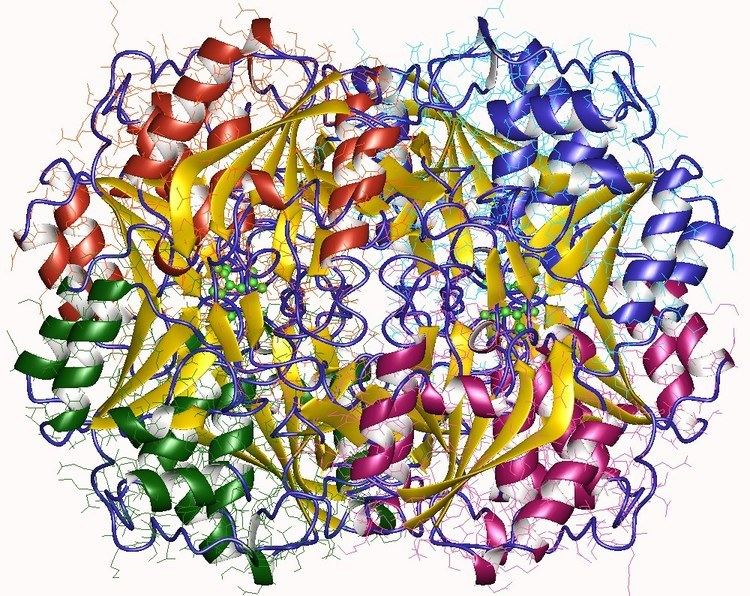Trade names Elspar, others MedlinePlus a682046 Routes ofadministration IM or IV CAS ID 9015-68-3 | AHFS/Drugs.com Monograph License data US FDA: Asparaginase Molar mass 31,731.9 g/mol | |
 | ||
Pregnancycategory AU: DUS: C (Risk not ruled out) | ||
How to pronounce asparaginase elspar memorizing pharmacology video flashcard
Asparaginase, also known as crisantaspase, is an enzyme that is used as a medication and in food manufacturing. As a medication it is used to treat acute lymphoblastic leukemia (ALL), acute myeloid leukemia (AML), and non-Hodgkin's lymphoma. It is given by injection into a vein, muscle, or under the skin. A pegylated version is also available. In food manufacturing it is used to decrease the acrylamide.
Contents
- How to pronounce asparaginase elspar memorizing pharmacology video flashcard
- Uses
- Medical
- Food manufacturing
- Side effects
- As a food processing aid
- As a drug
- Enzyme regulation
- History
- References
Common side effects when used by injection include allergic reactions, pancreatitis, blood clotting problems, high blood sugar, kidney problems, and liver dysfunction. Use in pregnancy may harm the baby. As a food it is generally recognized as safe. Asparaginase works by breaking down the amino acid known as asparagine without which the cancer cells cannot make DNA.
Asparaginase was approved for medical use in the United States in 1978. It is on the World Health Organization's List of Essential Medicines, the most effective and safe medicines needed in a health system. The wholesale cost in the developing world is about 42.00 USD for per 10,000 iu vial. This amount in the United Kingdom costs the NHS 613.00 pounds. It is often made from Escherichia coli or Erwinia chrysanthemi.
Uses
Asparaginases can be used for different industrial and pharmaceutical purposes.
Medical
E. coli strains are the main source of medical asparaginase. Branded formulations (with different chemical and pharmacological properties) available in 1998 include Asparaginase Medac, Ciderolase, and Oncaspar. (Crasnitin has been discontinued.) Spectrila is a new recombinant E. coli asparaginase.
Asparaginase produced by Erwinia chrysanthemi instead is known as crisantaspase (BAN), and is available in the United Kingdom under the trade name Erwinase.
One of the E. coli asparaginases marketed under the brand name Elspar for the treatment of acute lymphoblastic leukemia (ALL) is also used in some mast cell tumor protocols.
Unlike most of other chemotherapy agents, asparaginase can be given as an intramuscular, subcutaneous, or intravenous injection without fear of tissue irritation.
Food manufacturing
The most common use of asparaginases is as a processing aid in the manufacture of food. Marketed under the brand names Acrylaway and PreventASe, asparaginases are used as a food processing aid to reduce the formation of acrylamide, a suspected carcinogen, in starchy food products such as snacks and biscuits.
Side effects
The main side effect is an allergic or hypersensitivity reaction; anaphylaxis is a possibility. Additionally, it can also be associated with a coagulopathy as it decreases protein synthesis, including synthesis of coagulation factors (e.g. progressive isolated decrease of fibrinogen) and anticoagulant factor (generally antithrombin III; sometimes protein C & S as well), leading to bleeding or thrombotic events such as stroke. Bone marrow suppression is common but only mild to moderate, rarely reaches clinical significance and therapeutic consequences are rarely required.
Other common side effects include pancreatitis.
As a food processing aid
Acrylamide is often formed in the cooking of starchy foods. During heating the amino acid asparagine, naturally present in starchy foods, undergoes a process called the Maillard reaction, which is responsible for giving baked or fried foods their brown color, crust, and toasted flavor. Suspected carcinogens such as acrylamide and some heterocyclic amines are also generated in the Maillard reaction. By adding asparaginase before baking or frying the food, asparagine is converted into another common amino acid, aspartic acid, and ammonium. As a result, asparagine cannot take part in the Maillard reaction, and therefore the formation of acrylamide is significantly reduced. Complete acrylamide removal is probably not possible due to other, minor asparagine-independent formation pathways.
As a food processing aid, asparaginases can effectively reduce the level of acrylamide up to 90% in a range of starchy foods without changing the taste and appearance of the end product.
As a drug
The rationale behind asparaginase is that it takes advantage of the fact that acute lymphoblastic leukemia cells and some other suspected tumor cells are unable to synthesize the non-essential amino acid asparagine, whereas normal cells are able to make their own asparagine; thus leukemic cells require high amount of asparagine. These leukemic cells depend on circulating asparagine. Asparaginase, however, catalyzes the conversion of L-asparagine to aspartic acid and ammonia. This deprives the leukemic cell of circulating asparagine, which leads to cell death.
Enzyme regulation
This protein may use the morpheein model of allosteric regulation.
History
The discovery and development of asparaginase as an anti-cancer drug began in 1953, when scientists first observed that lymphomas in rat and mice regressed after treatment with guinea pig serum. Later it was found out that it is not the serum itself which provoke the tumour regression, but rather the enzyme asparaginase.
After researches comparing different kinds of asparaginases, the one derived from Escherichia coli and Erwinia chrysanthemi turned out to have the best anti-cancer ability. E. coli has thereby become the main source of asparaginase due to the factor that it is also easy to produce in large amount. Asparaginase produced by Erwinia chrysanthemi instead is known as crisantaspase (BAN), and is available in the United Kingdom under the trade name Erwinase.
